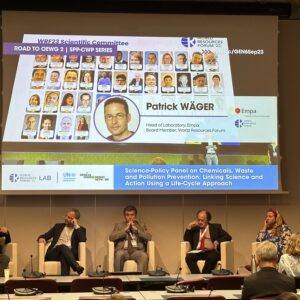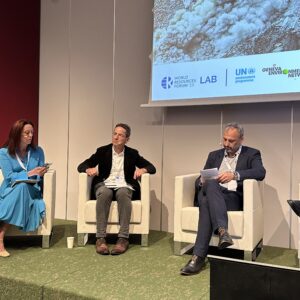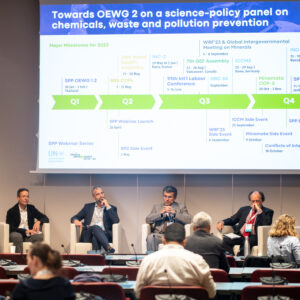Event Conference
Science-Policy Panel on Chemicals, Waste and Pollution Prevention: Linking Science and Action Using a Life-Cycle Approach | WRF2023 Lab / Road to OEWG 2 Series
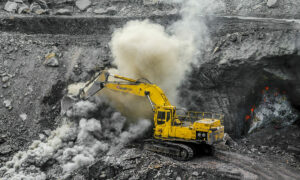
06 Sep 2023
11:00–12:30
Venue: CICG | Plenary B & Online | Webex
Organization: Ad hoc open-ended working group on a science-policy panel on chemicals, waste and pollution prevention, Geneva Environment Network
This World Resources Forum 2023 Lab aims to provide an interactive platform to seek input on relationships of the new Science-Policy Panel with stakeholders from the minerals and resources communities, through a life-cycle approach. After an introduction the ongoing OEWG process, the Lab will elicit initial views on possible linkages between the panel and the minerals and resources communities, which will inform the second meeting of the OEWG in December 2023. This side event is part of the Road to OEWG 2 Series, co-organized by the Secretariat of the OEWG and the Geneva Environment Network.
About this Event
Though chemicals play a vital part in daily life, science has shown that inadequate and poor management of chemicals and waste produced across value chains during chemicals’ life cycles has led to increasing pollution of land, water, and air. A life-cycle approach can help provide linkages between science and the actions needed to tackle the mounting pollution issues. It is expected that this science-policy panel will join existing science-policy panels such as IPCC and IPBES in addressing the triple planetary crisis of climate change, nature and biodiversity loss, and pollution.
This World Resources Forum 2023 Lab is an opportunity to provide an interactive platform to seek input on relationships of the new science-policy panel with relevant key stakeholders through a life-cycle approach – beginning with the minerals and resources community.
The Lab briefed this community about the ongoing ad hoc open-ended working group (OEWG) process that aims to establish an independent, intergovernmental science-policy panel to contribute further to the sound management of chemicals and waste and to prevent pollution. This Lab elicited initial views on possible linkages between the panel and the minerals and resources communities, approaching these from the full life cycle of chemicals.
Outcomes of the exchanges will inform the second meeting of the OEWG in December 2023.
About the World Resources Forum
The World Resources Forum 2023 Rethinking Value – Resources for Planetary Wellbeing, hosted by the Swiss Federal Office for the Environment and in collaboration with the United Nations Environment Programme, is taking place at CICG and online, from 4 to 6 September 2023. This edition acts as a platform bringing together stakeholders from industry, policy, civil society and research to co-create and share innovative solutions to the triple planetary crisis and enable wellbeing for all within planetary boundaries.
WRF’23 will focus on three conference tracks with a high-potential for transforming systems towards sustainability:
- Sufficiency: from a consumer to a sufficient society
- Value Chains: from extractive to regenerative value chains
- Digitalisation: from growth to purpose
Road to OEWG 2 Series
In preparation for the second session, the Road to OEWG 2 | Science-Policy Panel to Contribute Further to the Sound Management of Chemicals and Waste and to Prevent Pollution webinar and event series, co-organized by the OEWG Secretariat and Geneva Environment Network aims to build bridges between and among stakeholders, and promote collaboration and knowledge sharing in preparation for OEWG 2 in December 2023.
Previous webinars and events in the series have focused on the process for establishing a science-policy panel, its scope and possible structure (24 January 2023); lessons learned the Intergovernmental Panel on Climate Change (IPCC), Intergovernmental Science-Policy Platform on Biodiversity and Ecosystem Services (IPBES), International Resource Panel (IRP), Montreal Protocol, and World Health Organization (WHO) (5 October 2022); the scope of the panel (25 July 2022), operating principles of existing science-policy interfaces mentioned above, (26 April 2023); building bridges between and among stakeholders and raising awareness about the OEWG process (2 May 2023 as a side event to the 2023 BRS COPs); and how members of the Society of Environmental Toxicology and Chemistry (SETAC) can contribute their scientific expertise throughout the process (1 May 2023, during the European Special Session of SETAC Annual Meeting).
Speakers
By order of intervention.
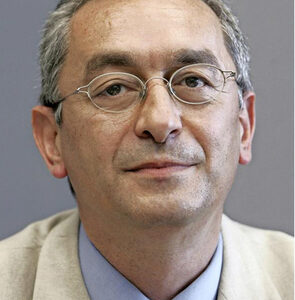
Bruno OBERLE
President, World Resources Forum
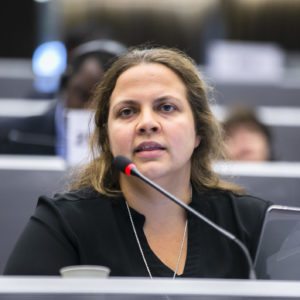
Valentina SIERRA
Permanent Mission of Uruguay to the United Nations in Geneva | OEWG on a Science-Policy Panel on Chemicals, Waste and Prevention of Pollution Bureau Member

Tessa GOVERSE
Principal Officer, Secretariat of the OEWG on a Science-Policy Panel on Chemicals, Waste and Prevention of Pollution, UNEP

Patrick WÄGER
Head of Laboratory, Empa | Board Member, World Resources Forum

Grégoire BELLOIS
Senior Policy Advisor, Intergovernmental Forum on Mining, Minerals, Metals and Sustainable Development, Economic Law and Policy Program, IISD

Georgios GEORGIADIS
Secretary, Convention on the Transboundary Effects of Industrial Accidents, United Nations Economic Commission for Europe

Yves LADOR
Geneva Representative, Earthjustice

Elisa TONDA
Chief, Resources and Markets Branch, United Nations Environment Programme | Moderator
Summary
Welcome
Elisa Tonda | Chief, Resources and Markets Branch, United Nations Environment Programme | Moderator
Today’s conversation will help explore the relationship between the negotiated science-policy panel and the resources community toward the goal of the sound management of resources and chemicals across the full life cycle. The milestone resolution (UNEP/EA.5/Res.8) approved at the Fifth UN Environment Assembly (UNEA-5) in March 2022 framed the intention to strengthen the relationship between science and policy in the context of the sound management of chemicals, waste, and the prevention of pollution. This called for the convening of an ad-hoc open-ended working group (OEWG) to prepare a proposal for a science-policy panel by the end of 2024. The OEWG convened for its first meeting and will meet in December 2023 for the second.
As we head towards the UNEA-6 in February 2024, another strategic assessment will be presented: the Global Resources Outlook, promoted by the International Resource Panel, with will bridge the interlinkages across processes including the SPP one.
Opening Remarks
Bruno OBERLE | President, World Resources Forum
We are living in a triple planetary crisis. Until now, only two science-policy bodies exist to address the climate and biodiversity crisis. The need and the importance of an international resources panel that looks at all these crises is urgently needed because natural resources are the necessary basis to produce those crises.
Even if there is a triple planetary crisis we know that these three crises are linked to each other: in fact, all three are the product of the same unsustainable production and consumption patterns and development systems. We have to work on the complexity of all these crises and to use wisely political will and political attention.
We have three crises, three knowledge bases, and one solution: the need for coordination. Natural resources are necessary for the development and for our societies. The 2019 Global Resource Outlook analyzes very linearly the development of natural resources, finding that our consumption passed from 30 gigatons 50 years ago to 90 gigatons today. The increase in extraction and use of natural resources is explained by the increase of the world population and the consequent rise in the demand for infrastructure.
The cope with the infrastructure and product demands for a future sustainable society, additional natural resources, also called transition minerals will be increasingly tapped upon. The impact of extraction of natural resources and the consequences on planetary and huam health health need to be carefully assessed as the GCO indicated that resource extraction could lead to up to 80 percent of biodiversity disappearance, on top of contributing to particulate matter emissions.
To avoid an energy transition that depletes the planet from precious resources and transforms them into crises aggravators, it is recommended to coordinate different workstreams and look at the different sectors of the economies.
Valentina SIERRA | Permanent Mission of Uruguay to the United Nations in Geneva | SPP OEWG Bureau Member
At its fourth session in 2019, UNEA recognized that science was needed to set priorities for policy-making and to monitor progress. It also stressed the urgent need to strengthen the science-policy interface at all levels mainly to support and promote a science-based local national, regional and global action on the sound management of chemicals and waste.
The urgency to support the establishment of a science-policy panel started to gain more recognition and importance as it represents an urgent need, especially for developing countries. All the assessments are needed to make good decisions and to elaborate policies so that’s why we need these kinds of panels to shape and develop effective policies and to ensure that scientific evidence is available to all.
A group of countries which included Uruguay, Costa Rica, the UK and Switzerland proposed the draft resolution, later adopted at the fifth session of the UNEA on the establishment of a Science-Policy Panel On Chemical Waste and Pollution Prevention. The establishment of this science-policy panel will help us to address the third pillar of this triple planetary crisis.
The SPP must promote synergies with other bodies addressing the international management of chemicals including the Strategic Approach to International Chemicals Management (SAICM), and link with the Beyond 2020 framework expected to be adopted at the upcoming ICCM5.
The addressing of the pollution and waste crisis must also be inclusive and equitable. We need to take into account the diverse needs and perspectives of different stakeholders, for all people and communities, especially groups in vulnerable situations, It is therefore essential to incorporate a human-rights approach. Indeed, these groups in vulnerable situations are often heavily impacted by resource extraction and waste.
To face this triple planetary crisis we need a science-driven and inclusive policy-making. That is not just a moral imperative but it is a practical necessity to ensure the right to a clean, healthy and sustainable environment; in fact, by working together taking into account knowledge from science, and using the best available science-policy tools we can create more resilient and sustainable future for all and we need to start here from working with each other.
Introduction to the SPP
Tessa GOVERSE | Principal Officer, Science-Policy Panel on Chemicals, Waste and Prevention of Pollution, UNEP
The Science-Policy Panel to contribute further to the sound management of chemicals and waste and to prevent pollution (SPP) could really support countries in their efforts to take action, including implementing multilateral environmental agreements and other international instruments to promote the sound management of chemicals and waste and address pollution. They also could further support relevant multilateral agreements, and other international instruments and bodies as well as the private sector and other relevant stakeholders in their work.
Linkages between the SPP and the resources community are multiple. Recycling, disposal of waste, and emissions generated without proper control or preventive measures end up in the environment and cause various forms of pollution and impacts on human health and ecosystems. Therefore, it is important that the works of the SPP, even prior to its establishment are tightly supported by the knowledge of the resources community.
The working groups on the SPP it is at halfway through the process, having had two split it sessions of the first meeting of the open-end working group and preparing for its second session that will take place in December this year, a third and last meeting of the open and working group is then planned for the middle of next year, and there will be an intergovernmental meeting at the end to officially establish the panel and start its work.
At this first meeting, the open-end working group discussed the objective of the science-policy panel and established that “The objective of the panel is to strengthen the science-policy interface to contribute to the sound management of chemicals and waste and to prevent pollution for the protection of human health and the environment”. The text of the objective has been left in brackets with the understanding that future discussions of the open and the working group may continue to inform the objective, in the open-ended working group also discussed.
The functions of the panel were also outlined and agreed upon in resolution 5/8.

The next big milestone is the second meeting of the open-end working group which will take place on 11 – 15 December 2023, in Jordan and will be preceded by a series of regional meetings in the lead-up to this meeting.
Items on the current draft agenda include Preparation of proposals for the establishment of a science-policy panel, which will feature discussions on Relationships with relevant key stakeholders to identify how stakeholders may contribute to the panel’s work beyond those described in the work-related processes and procedures, in other words how to become partners and to take on specific work such as knowledge management, information sharing and capacity building. This will also include discussions on how stakeholders may provide input to the development of the panel’s work program by nominating experts and preparing deliverables such as assessments. Since we will have only two more meetings left the second meeting of the open-ended working group will be a cornerstone for the establishment of the panel.
Building Linkages from Science to Support Action with the Mineral Resources Communities
Patrick WÄGER | Head of Laboratory, Empa | Board Member, World Resources Forum
According to the International Resources Panel, extraction processing of material resources is responsible for 90 of biodiversity loss 50 of global greenhouse gas emissions, and 30 of air pollution impacts. Pressure on the environment is expected to further increase because of growing demands for mineral resources, among others. The energy transition and the expansion and renewal of the infrastructure will require a lot of mineral raw materials on a global level. The expected increase in demand for mineral resources and in particular critical minerals and raw materials will raise questions on supply security. To enact the transition to a sustainable energy economy transition will require expanding capacities and collaboration at the international level.
Primary raw materials mining, extraction, and processing mostly take place in the Global South. Massive environmental impacts are also associated with health and safety as well as social issues such as child labor. The 2021 IEA report The Role of Critical Minerals in Clean Energy Transitions – revised in 2022 – found that the global demand for all critical minerals will quadruple by 2040, for example, the demand for lithium in the sustainable development scenario will increase by a factor of about up to 40.
Scientific sessions and workshops organized in the context of the World Resource Forum hosted discussions on various aspects related to supply chains of minerals and other resources. Sessions tackled critical and strategic raw materials, discussing the Critical Raw Materials (CRM) Act Proposal, issued in March, featuring also strategic materials, such as copper. This document focuses on these supply risks, in particular reflections and mitigation activities. In these sessions and workshops organized in the framework of the WRF, we had inputs from multiple projects addressing circularity issues related to critical raw materials which are planning to to or already are informing policy at the European Commission level.
The lifecycle approaches were prominently represented at this conference as methodologies like life cycle assessment, and life cycle sustainability assessment, are needed to inform policy and project making. To stress the interconnectedness of minerals and material sustainability, other sessions featured planetary boundaries, the energy climate change and materials nexus, with contributions, amongst others about the dynamic interrelations between energy and the energy and the materials transition which is underinvestigated.
There is also the idea of doing further research in that direction and another presentation about Multi-Factor Authentication (MFA) and Life-Cycle Assessment (LCA) based tools to determine material flows and greenhouse gas emissions of the Swiss economy. The Swiss Federal Office for the Environment, is now using this tool for policy making, this is also a good example of a science-policy interface.
Grégoire BELLOIS | Senior Policy Advisor, Intergovernmental Forum on Mining, Minerals, Metals and Sustainable Development, Economic Law and Policy Program, IISD
The Intergovernmental Forum on Mining, Minerals, Metals and Sustainable Development (IGF) is a global forum of mining processing countries from all over the world. Currently composed of 81 member countries, its goal is to improve mining governance to achieve the SDGs. The IGF is a voluntary initiative created through the United Nations during the World Summit on Sustainable Development in Johannesburg in 2002.
IGF supports its member countries by doing in-country assessments of their policies, laws and regulations in relation to mining and sustainable development through capacity building and technical assistance, developing guidelines in relation to all the aspects of mining and sustainable development. IGF embeds case studies across their outreach work as these help member countries to learn what the other players do, what does not work, what are the successes and what are the challenges. Besides countries, IGF also collaborates with regional organizations such as the Association for Southeast Nations (ASEAN) for Southeast Asia, and the Economic Community Of West African States (ECOWAS). All IFG members will be gathered in Geneva to exchange about mining and sustainable development during its annual meeting from 7 to 9 November 2023.
Thanks to our work we now know that a huge amount of metals can be extracted from open pits, and the biggest open pit in the world is the Palabora Copper mine in South Africa, two kilometers wide at 100 meters deep. While the pit is the most impressive part visually, real impact occurs all around where tailings and the waste dumps.
 Copper mining generates an enormous amount of waste compared to the percentage of extracted copper. In the case of gold is one gram proton per million. The mining sector is the biggest emitter of waste in the world, more than 100 billion tons of waste per year and this number will only increase dramatically because higher-grade deposits have been exploited, The combination of lower grades deposits and more mining to respond to this energy transition that will bear an enormous impact on the environment.
Copper mining generates an enormous amount of waste compared to the percentage of extracted copper. In the case of gold is one gram proton per million. The mining sector is the biggest emitter of waste in the world, more than 100 billion tons of waste per year and this number will only increase dramatically because higher-grade deposits have been exploited, The combination of lower grades deposits and more mining to respond to this energy transition that will bear an enormous impact on the environment.
The mining industry uses a lot of chemicals, the most important one being mercury. Artisanal and Small-Scale Gold Mining (ASSGM) employs mercury to amalgamate gold and separate it from the rest of the ore and thus a larger emitter of mercury in the world. Cyanide is used for gold extraction, mostly by small-scale mining. Sulfuric acid is a byproduct of mining, which leads to acid rock drainage, the biggest source of pollution from mining. It occurs when rainwater t goes through waste rocks and the rain dilutes and transforms into acid water that enters into river streams, causing the destruction of ecosystems and the accumulation of heavy metals. Therefore, mining causes chemical pollution that is transported through air and water and expands well beyond mining areas.
We support countries in improving the mining regulations, including tailing storage facilities but that is not yet to be considered fully efficient. Current management practices build on and collaborate with other instruments and MEAs.
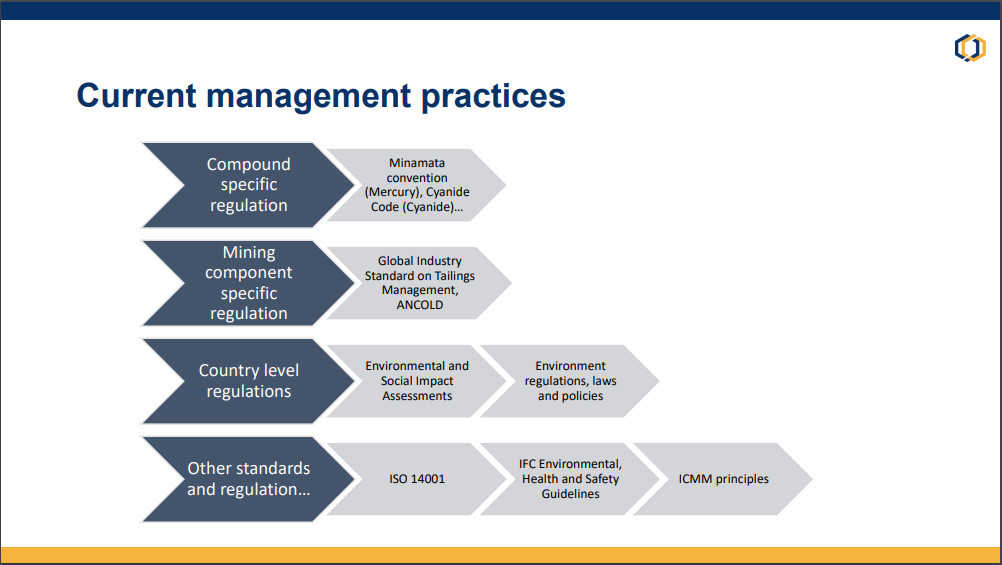
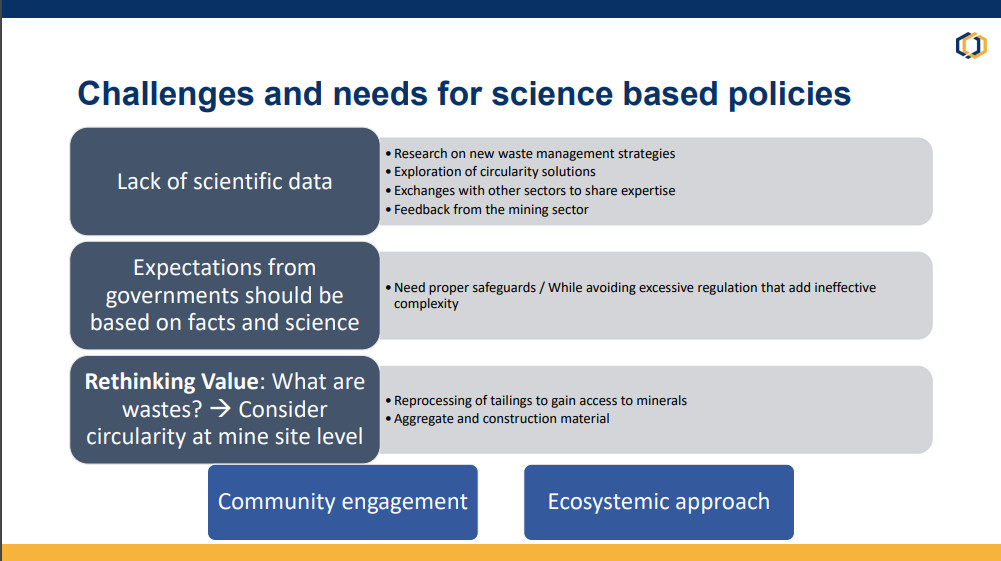
Georgios GEORGIADIS | Secretary, Convention on the Transboundary Effects of Industrial Accidents, United Nations Economic Commission for Europe
The core idea of the work of the UNECE Convention on the Transboundary Effects of Industrial Accidents is
to assess current trends and develop the best possible tools and guidance to prevent these from resulting into accidents.
Global Key Trends and Challenges
- Critical Raw Materials (CRM): The decarbonization agenda and the energy transition are driving a surge in the demand for critical raw materials. This creates several issues such as potential shortages, trade dependency, geopolitical challenges, and increasing tailings management facilities (TMFs) risks;
• Hazards and Risks of Tailings Management Facilities (TMFs): Due to lack of knowledge of TMFs (number, location, state, condition), transboundary effects of TMFs, and effective management of TMF risks for prevention
• Natural Hazards Triggering Technological Disasters (NATECH) Events: Natural hazards, frequent and severe weather events of climate change increase risk of TMF failures & transb. impacts
All these increase costs, and the difficulty of tackling the issues once they happen, so risks on tailings due to extreme weather but also due to the exponential rise of these sites. There are significant costs for emergency responses, especially in certain parts of the world where the structures are weak and therefore create huge issues on cleanup repairs disruption of economic activities: claims for damages and legal costs for governments, human health and the environment, which is the overarching framework.
Key messages for the Science-Policy Panel
- A life cycle approach can help reduce pressure and prevent pollution. Life-cycle approach & sustainable
resource management are important to manage the green transition and achieve SDGs, including environmental sustainability. - Integrated risk management must be part of the thinking because the impact is no longer simply what happens on-site, it also implies factoring in climate change and natural disasters, in terms of the costs or the benefits of the prevention.
- Political and technical knowledge is often lacking, evidencing the need for better data collection and analysis. It is very important to map TMFs, because they are the key to being able to understand what the risks are associated with them.
- Need for accelerated policies, innovations and research on reducing, reusing & recycling tailings (circular economy) part of the secure economy must become a thought in itself: precisely because of how rare earth materials work, and the value of these materials it is very important to be able to make best use of existing sites.
- Systematic reporting and regular information exchange allow gathering information over time so we understand the evolution. For regular information exchange on lessons learned, several platforms are in place, some are voluntary, others are more formal but favor the diffusion of good ideas and good practices.
- Strengthening safety and governance and preventing accidents on all TMFs as some of the major axes occur in inactive or closed facilities. Multi-stakeholders cooperation and inclusion of local populations are essential for sharing information and knowledge.
The Convention has 42 Contracting parties, it is focused on UNECE but produces materials, policy tools and knowledge with global scope and global relevance.

- The 2030 Road Map for Action on Tailings Safety in the UNECE Region and Beyond is now in the phase of understanding risks associated with tailings reviewing and updating existing measures and legislation, usually creating new working groups and National coordination mechanisms, because coordination within a country is essential and report tailings discussions activities that is part of our regular reporting. In the next two years until 2026 we will prepare an overview of tailing facilities in the UNECE region and possible existing threats, improving shared understanding and risk management across countries increasingly of relevance.
- Other UNECE tools include the United Nations Framework Classification for Resources (UNFC) and the United Nations Resource Management System (UNRMS), which are innovative tools for sustainable resource management.
- We are witnessing an interesting trade-off at the moment between climate action and all these massive impacts on the environment due to the increased mining which underlines the energy transition that will enable climate action. While it feels like choosing the least of two evils, a science-policy panel can help in enabling us to understand what is happening.
Yves LADOR | Geneva Representative, Earthjustice
This discussion comes at a timely moment, right before SPP negotiations and before the International Conference on Chemical Management (ICCM5) . We are faced by multiple challenges and by a wealth of information toxics, and so to have a science-policy body that can help to see where the science is consolidated to the gaps is very much needed. The contribution of this body will not add to the list of already numerous bodies of experts, the body will offer a global view to see where the gaps are, and where are the priorities in terms of research.
Links with the Human Rights Council
Both the Human Rights Council and the Office of the High Commissioner (OHCHR) are actively involved in addressing triple planetary crisis. The Human Rights Council has three special procedures which are independent being themselves scientist. The Council has a political body on the different elements of these triple planetary crises, the oldest mandate actually is a mandate created in 1995 which is the UN Special Rapporteur on toxics and human rights, now in the hands of Dr. Marcos Orellana.
Over the years, the procedure of the Special Rapporteur on Toxics and Human rights various issues such as the impact of mining on indigenous people, local communities, with an upcoming report to be presented at the upcoming 54th session of the Human Rights Council on how we detoxify the decarbonization process. The report is particularly relevant to the SPP process and should be considered as a basic document as well as its report on The Right to Science in the context of toxic substances.
Although the notion of the right to science seems very ambitious, it is ever more important in a world of growing disinformation. Without a solid scientific basis, we are just losing light in a very dark situation. Science is the only avenue to understand our environment and its changes under the triple planetary crisis.
For the achievement of the right to science, conditions include having an enabling environment for science to flourish. There we can see a very direct link to human rights: without freedom of expression, and freedom of access to information there is no free science. This right also stresses the importance of having access to the methodologies and findings, particularly important in the field of hazardous subside substances, but it means also that governments here have a duty to make sure that people can have access to this information, and this, unfortunately, is an element which is very often lacking.
The question of disseminating this information is absolutely crucial for the political debate, so that does not happen in a separate format: indeed, there are three elements that the Special Rapporteur is focusing on when we talk about effective science-policy interface as being a model for the implementation of the right to science:
- work on the best available science- reproducible data and analysis from the different unbiased sources;
- include the precautionary principle,
- work with the engagement of all relevant stakeholders.
The issue of chemical minerals is particularly linked to these aspects as certain information is in the hands of private actors. Private information is ruled differently from public information.
The precautionary principle can be tricky but in the SR report, it is backed by various constitutional references laying the grounds for this principle. The precautionary principle is essential, especially in contests where knowledge gaps exist.
An effective science-policy interface must exist in a dialogue with all stakeholders, from states to industries, but it means also with the affected communities. That is where you have a difference between the SAICM or the ICCM5 questions and the SPP approach. With the SPP we are talking about scientific information, which also lies with communities, and should be taken into consideration if we are looking for the policy relevant information that has to be delivered to the policy makers.
Tactics to divert attention | We also have to be very careful and keep in mind tactics from different groups and different interests that are trying to divert science on climate change and climate denial. We unfortunately have a number of experiences where we are not in a neutral ground.
Private and confidential data | Data that is not public and cannot be accessed represents a challenge, blocking necessary scientific information for policymakers to make their decisions.
Conflicts of interest pose a direct threat to the right to science, particularly in the toxics context. They can undermine scientific integrity, cause confusion and erosion of public trust in science and harm health
and the environment. These arise when scientists are employed or promised employment, whether funded or contracted, or otherwise derive benefit from a business entity or industry about which they are doing research
and communicating findings.
We do have attacks against harassment and working in the field of Human Rights Council, we have to consider today a number of scientists as being human rights defenders. We even have seen family of scientists being threatened because of the information scientists were putting out. This is becoming a real issue and the scientific community must take bold step to prevent it.
Q&A
Q: What would you recommend for the resource community to be motivated and to be connected with the SPP conversation?
Patrick WÄGER: What is done at the scientific level actually is relevant in order to raise the level of knowledge and awareness, and also to provide links to it and to establish procedures in a certain way to make this transfer. If you feel that you really can contribute as a scientist to something that has a global impact on such relevant issues of course it is about sustainability in the end, it is about justice and responsibility which are topics that are important motivators.
Q: Many of the things we have just heard such as sustainability in raw material, supply chains, waste circularity are also issues that the international resource panel also mentioned. So, how would you foresee ideal cooperation and partnership exchange in the future to create synergies and avoid duplications?
Grégoire BELLOIS: The engagement benefits and the social security benefit can be shared, this is going to be the topic of our next IGF in November on how all this energy transition affect the people.
Q: What are the questions that scientists can ask? What are the methods being used given that SPPs are creating these guidelines and recommendations? Are they catered or tailored to different countries?
Georgios GEORGIADIS: Tailored advice is very important. Usually in our line of work the way that would happen is through capacity development, and capacity building activities where we take our general tools and apply them in the country. Of course, in our case, the Convention is a result of the decisions of its contracting part but all the knowledge products, and all the policy tools that we’re issuing have global relevance. To achieve fundamentals for the mining business and developing all these TMFs guidelines, there has been consistent systematic work. It is currently concentrated on addressing the rising demand for energy transition to tackle climate change. As institutional, legal and technical frameworks are often lacking, this is a recipe for an accident waiting to happen. What the SPP can do is channel the knowledge accumulated in different contexts to the benefit of the broader local and global communities. It should not be about choosing the list of two evils, and we have good knowledge, good sound principles and ways to channel them. It is just that people have to go in these directions, and somebody has to steer them.
Q: What would it take to consider these rocks that could be used as aggregate? What is blocking us from making it available for building material in terms of legislation?
Grégoire BELLOIS: In this situation, it can be doable from the beginning, from the design of the mining operation. When mining operations are conducted, aggregate is produced but is almost never considered in the feasibility study. This is an effect of lacking communication among different stakeholders in the construction sector as they work in silos. A solution would be co-generation. What is important to understand is whether generated waste material can be chemically active, in that case, it needs to be notified before being used, despite its mechanical qualities. To ensure a circular initiative does not become a stressor on health, there is also a need for a legislative change in mining countries. We will try to bring awareness to the power of co-generation as a way to limit the amount of waste.
Half of the critical minerals that are necessary for the energy transition are byproducts as there are no mines for those. So, in these tailings, there are many interesting useful elements for the extraction of which much energy and money has been put, and causing the suffering of many communities. It is our duty to make sure that this valuable mineral needed for the green transition takes into account all the consequences of creating new mines.
Q: How can the science-policy panel help promote social and environmental justice in the mining sector, so that even vulnerable communities can also enjoy the economic benefit of the activities that impact them so much?
Yves: It is exactly what member states will have to negotiate. There will be a mandate exactly like for the IPCC or IPBES, AND different working groups in different work streams to address the multiple dimension of the problem. Among these it is fundamental to identify information gaps. So, this is exactly where the SPP will be able to play a very important role. Special the session of the Human Rights Council will talk about the notion of “Just transition” is so crucial in the field of climate change now it has also been used in other fields like the question of chemical toxics and so on. So, it is something very important and hopefully, also SAICM will be able to have this on its agenda because we need to do these kinds of interlinkages. What is needed is more cross-sectional discussions because we need the SPP. We do not need to build so many more institutions; we have to make sure that a lot of the knowledge that exists in these different places are able to be channeled in a useful way and in a relevant way.
Grégoire BELLOIS: We really need to make sure that we engage communities, that we discuss with them and we do not impose solutions but we make sure that there is a co-construction of earth solutions. Again it is really basic: it has been decades that we are saying this but it still does not happen on the ground so it is worth saying it again.
Valentina SIERRA: We need to work together, to talk to each other to see how we could identify gaps. The inputs are fundamental in informing how the SPP can help. From all the answers to the questions, prevention is really important. It is not only the prevention of pollution but also the prevention of the impacts on society: we need to take into account the impacts on vulnerable groups and ensure societies can benefit from its work.
Highlights
Video
Live on Webex.
Live in the Room
Photo Gallery
Links
- Presentations made during the event
- Road to OEWG 2 | Science-Policy Panel to Contribute Further to the Sound Management of Chemicals and Waste and to Prevent Pollution / SPP-CWP Series
- 2023 World Resources Forum | Rethinking Value — Resources for Planetary Wellbeing (WRF23)
- Mineral Resource Governance and the Role of Geneva






